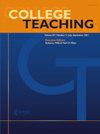Student Perceptions about HyFlex/Hybrid Delivery of Courses during the COVID-19 Pandemic
Q3 Social Sciences
引用次数: 1
Abstract
This empirical study examined undergraduate college students' perceptions about HyFlex/hybrid courses during the COVID-19 pandemic. A total of 305 students (73 male, 234 female) completed an online survey that assessed technological strategies, instructional strategies, and perceptions about HyFlex classes. Students indicated that most of their classes during the Spring 2021 semester were a mix of in-person and online, and professors used Google Meet for classes, and the learning management system (LMS) for assignments, syllabi, and rubrics. Student perceptions about their HyFlex classes indicated that they felt challenged in their classes and that course materials were available to them "during” and "after” class. Students also felt a lack of "connection” with other students in the class and were unsure if HyFlex improved their learning. Some of the aspects students liked about the HyFlex model included the "freedom to choose whether to attend in-person or virtually” (66.9%) and "flexibility to view lectures at my own pace” (55.4%), while aspects of the HyFlex model they did not like included "technology issues” (67.5%) and "not enough interaction with my classmates” (60.7%). Two open-ended questions generated comment themes with students indicating the need for classroom flexibility, classroom engagement, instructor communication, leveraging technology, and minimizing distractions. [ FROM AUTHOR] Copyright of College Teaching is the property of Taylor & Francis Ltd and its content may not be copied or emailed to multiple sites or posted to a listserv without the copyright holder's express written permission. However, users may print, download, or email articles for individual use. This may be abridged. No warranty is given about the accuracy of the copy. Users should refer to the original published version of the material for the full . (Copyright applies to all s.)COVID-19大流行期间学生对HyFlex/混合交付课程的看法
本实证研究调查了2019冠状病毒病大流行期间本科生对HyFlex/混合课程的看法。共有305名学生(73名男性,234名女性)完成了一项在线调查,评估了技术策略、教学策略和对HyFlex课程的看法。学生们表示,他们在2021年春季学期的大部分课程都是面对面和在线结合的,教授们使用Google Meet来上课,使用学习管理系统(LMS)来布置作业、教学大纲和大纲。学生对HyFlex课程的看法表明,他们在课堂上感到有挑战,课程材料在“课中”和“课后”都可以使用。学生们还感到与班上其他学生缺乏“联系”,不确定HyFlex是否改善了他们的学习。学生们喜欢HyFlex模式的一些方面包括“可以自由选择是亲自上课还是虚拟上课”(66.9%)和“可以按照自己的节奏灵活地观看课程”(55.4%),而他们不喜欢HyFlex模式的方面包括“技术问题”(67.5%)和“与同学的互动不足”(60.7%)。两个开放式问题产生了学生们的评论主题,他们指出了课堂灵活性、课堂参与度、教师沟通、利用技术和减少干扰的必要性。College Teaching的版权归Taylor & Francis Ltd所有,未经版权所有者的明确书面许可,其内容不得复制或通过电子邮件发送到多个网站或发布到listserv。但是,用户可以打印、下载或通过电子邮件发送文章供个人使用。这可以删节。对副本的准确性不作任何保证。用户应参阅原始出版版本的材料的完整。(版权适用于所有人。)
本文章由计算机程序翻译,如有差异,请以英文原文为准。
求助全文
约1分钟内获得全文
求助全文
来源期刊

College Teaching
Social Sciences-Education
CiteScore
1.50
自引率
0.00%
发文量
33
期刊介绍:
College Teaching provides an interdisciplinary academic forum on issues in teaching and learning at the undergraduate or graduate level. The journal publishes three kinds of articles. Regular, full-length articles of up to 5,000 words reporting scholarship on teaching methods, educational technologies, classroom management, assessment and evaluation, and other instructional practices that have significance beyond a single discipline. Full-length articles also describe innovative courses and curricula, faulty development programs, and contemporary developments. Quick Fix articles, up to 500 words, present techniques for addressing common classroom problems. Commentaries, up to 1,200 words, provide thoughtful reflections on teaching.
 求助内容:
求助内容: 应助结果提醒方式:
应助结果提醒方式:


